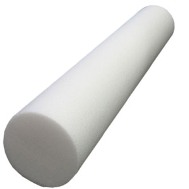The Foam Roller is a great tool to rehab your own aches and pains. It can transform how you feel in a restricted area and make pain disappear. Many people do not get this success though because they do not use the foam roller correctly. The two biggest errors I see is one, rolling up and down on the foam roller (yes the roller part is deceiving) and using it on areas it shouldn’t be used on.

Assessing which muscles to use with the foam roller
The foam roller can be used on many different muscles groups including the calves, shins, thighs, ITB, hamstrings, TFL, glutes and lats. This list of muscles is even greater if you include similar tools to the foam roller such as tennis balls, medicine balls and various message devices.
The most important element to foam roller rehab success is knowing which muscles to use it on. Just like with stretching the key for success is identifying the tight muscles and releasing these. The majority of people could benefit from starting on the thigh musculature. For an in-depth analysis consider taking the Kinetic chain assessment and posture analysis.
The goal of a roller is to restore posture back to ideal position. This can mean posture in general or more specifically releasing a joint back to its ideal angle so less pain is felt on movement.
Pain
When you apply the foam roller to muscles that have large amounts of tension you will normally experience pain. This can be severe. Use common sense in enduring this and look at ways to spread the weight of your body to lessen the pressure of the muscle on the foam roller. Over time the muscles will become less and less painful.
Foam roller techniques
Once you are using the foam roller on a muscle that needs releasing you can use one of three different methods:
Up and down rolling
You can simply roll up and down the foam roller along a muscle group. This is the least effective method for reducing muscle tension and in my experience almost pointless. The foam roller is not subtle enough to give the effects of a human hand massage rubbing up and down so this process yields little results.
Hold and and release
Taking a slower approach to the foam roller is more effective. At each site of pain stop moving and give the body time for the pain to release. This may take from 15 seconds to a minute. At this point move slowly further up the muscle again stopping at the next site of pain until it releases. Repeat for the whole muscle. Using this technique you can go along the muscle from the beginning to the end.
Soft tissue release
Soft tissue release involves using the foam roller on the muscle but also moving the limb to create stretch in that same muscle on the foam roller. This is effective at breaking down fascial restrictions.
Knowing Which Muscle Pain is Protecting or Causing The Problem
Not all muscle pain experienced is bad when you apply the foam roller. While some tension in the muscle is distorting the joint angle, and thus creating pain when you move. Other tension areas in the muscle are there to prevent further distortion of joint angle and thus preventing further pain. The best way to check this process out is to always retest the injury after clearing a part of tension within the body. If the injury/pain improves then that is a sign it has helped the area, if it worsens then there is a good chance this muscle tension is not the cause of the injury itself.
Using Tennis, Lacrosse and Golf Balls Over The Foam Roller
While the traditional roller is great in that it addresses muscle tension across a large area many tense areas of the body are better served using a smaller device like golf, tennis or lacrosse balls. These have the same effect and benefit of foam rolling. This is because the results come from the way you use the device over what type of device you use. Using the foam roller on the back, (glutes to lesser extent) yields almost no results because it is too big to get to work. The substitution of using balls gets around this problem.
Massage or Rollering?
A massage therapist will always be more beneficial than a foam roller. Usain Bolt has 3+ massages a day to keep his muscles tension free, however, most normal people do not have access to a massage every day. In this case foam rollering become an important tool to aid rehab.
*********************
Need Support Getting In Shape?
For support, coaching, nutrition and exercise plans wherever you are in the world read more here>>>>
For personal training in London Zones 1 – 2 read more here>>>>
*********************
************************
Battersea – For Personal Training Battersea please contact me. I am available for sessions in homes, private gyms or Personal Training Battersea Park
Battersea park was created in 1858. Battersea Park is considered one of London’s most interesting Parks housing Battersea Zoo, Battersea Evolution Exhibition Centre and of course Battersea Park Dogs & Cats Home.
*****************************